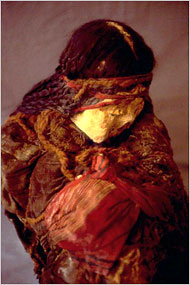 “Braided hair is intact on a Peruvian mummy like those used in a study. Scientists say lice in the Americas predated Columbus.” Source of caption and photo: online version of the NYT article quoted and cited below.
“Braided hair is intact on a Peruvian mummy like those used in a study. Scientists say lice in the Americas predated Columbus.” Source of caption and photo: online version of the NYT article quoted and cited below.
(p. A10) When two pre-Columbian individuals died 1,000 years ago, arid conditions in the region of what is now Peru naturally mummified their bodies, as well as the lice in their long, braided hair.
That was all scientists needed, they reported Wednesday, to extract well-preserved louse DNA and establish that lice had accompanied their human hosts in the original peopling of the Americas, probably as early as 15,000 years ago. The DNA matched that of the most common type of louse known to exist worldwide now and also before Europeans colonized the New World.
The findings absolve Columbus of responsibility for at least one wrong unintentionally wrought on the people he found in the Americas and called Indians. The Europeans who followed Columbus to America may have introduced diseases, namely smallpox and measles, but not the most common of lice, as had been suspected.
For the full story, see:
JOHN NOBLE WILFORD. “Scientists Say Mummies’ Lice Show Pre-Columbian Origins.” The New York Times (Thurs., February 7, 2008): A10.
